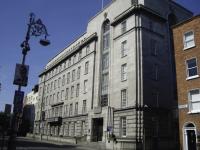Department of Industry and Commerce, Kildare Street
Published in 20th-century / Contemporary History, Gems of architecture, Issue 6 (Nov/Dec 2012), Volume 20 One of Dublin’s architectural gems is the old Department of Industry and Commerce (now Jobs, Enterprise and Innovation) building at nos 24–28 Kildare Street, formerly the site of the Maples Hotel mentioned in James Joyce’s Portrait of the artist as a young man. After independence the Department of Industry and Commerce occupied various buildings around Dublin. In February 1935 a supplementary estimate was introduced in the Dáil for ‘the building of new offices for the Department of Industry and Commerce on the vacant site of Maples Hotel’.
One of Dublin’s architectural gems is the old Department of Industry and Commerce (now Jobs, Enterprise and Innovation) building at nos 24–28 Kildare Street, formerly the site of the Maples Hotel mentioned in James Joyce’s Portrait of the artist as a young man. After independence the Department of Industry and Commerce occupied various buildings around Dublin. In February 1935 a supplementary estimate was introduced in the Dáil for ‘the building of new offices for the Department of Industry and Commerce on the vacant site of Maples Hotel’.
A public competition for the design was won by Cork architect J.R. Boyd Barrett. Construction by John Sisk and Sons took place between 1939 and 1942 and was greatly delayed by the difficulty of obtaining materials (particularly steel) during the Emergency. Grey slabs of limestone and granite divide the front façade into the ‘traditional’ hierarchy of base, middle and capping parapet. The low cornice continues the line of the adjacent Georgian buildings, while that above screens out the uppermost floor. Boyd Barrett’s design organised offices and secretarial areas about a continuous corridor that follows the line of Kildare Street and Schoolhouse Lane to form an extended ‘L’. This ‘L’ is six storeys above street level and opens out towards the south and west.
Of the front of the building (in a 1992 OPW booklet to mark its 50th anniversary) architect Raymund Ryan commented that ‘Detail is modestly stylised and reduced towards the kind of “truthful” minimalism spreading in from the Bauhaus’. Elsewhere, the building has been described as displaying an unusually successful blend of classical and contemporary art deco characteristics; it has been said that, overall, the cleanly defined articulation and bold stylisation are reminiscent of New York’s inter-war architecture.
The north-eastern corner at the junction with Schoolhouse Lane has multi-storey bands of steel-framed glazing with keystone busts representing ‘Éire’ and ‘St Brendan the Navigator’, with zigzag and chevron patterns in the interstitial panels. The winning designs for the friezes (which were personally inspected by the then minister, Seán Lemass) were submitted and executed by Gabriel Hayes (that she was a woman caused a great deal of press comment at the time). The model for the female figure of Éire is reputed to have been the mother of a subsequent minister for industry and commerce, Peter Barry.
The drawings on the large panels of the balcony outside the ministerial suite represent the Shannon hydroelectric scheme, as well as the important new cement industry. Smaller panels depict other manufacturing sectors, such as spinning, pottery, shoemaking and the tobacco industry. The long vertical window on this side of the building surmounts a square door arch, which has a lintel relief depicting the Celtic god of light, Lugh, releasing a flight of aeroplanes, to reflect the department’s responsibility for the fledgling aviation sector. The door itself consists of two massive bronze gates, weighing one and a half tons, cast by J. & C. McLoughlin of Pearse Street and fabricated (because of wartime constraints) in single pours.
The building’s flat roof gives great views of the city. The plant room in the rear basement, with its many pumps, switches and dials, has been described as like something from the set of Fritz Lang’s Metropolis. The basement along Kildare Street became an air-conditioned bomb shelter for government officials—at this time Lemass was not just minister for industry and commerce but also headed up the vital ‘Emergency’ department of supplies. Today this historic subterranean space is home to nothing more threatening than neat arrays of civil servants’ bicycles. HI
Brian McCabe is a retired civil servant who spent many years in the building. Series based on the National Inventory of Architectural Heritage’s ‘building of the month’, www.buildingsofireland.ie.
'
















